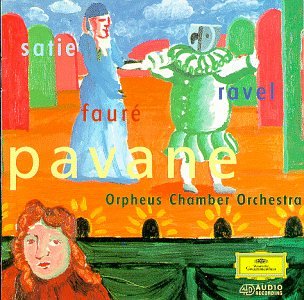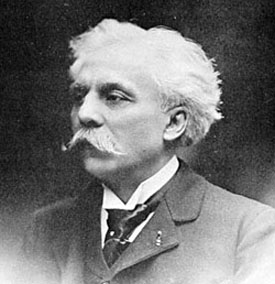This week’s theme is…Pin the Tail on the Donkey! Like many music lovers I boast an extensive and comprehensive record collection. For this week, I closed my eyes and selected 5 different albums. Here’s what I picked…

Pin the Tail on the Donkey, Day 4 – Sicilienne from Peleas and Melisande by Gabriel Faure

In the late 1800s a group of French and Belgian writers began to compose prose and poetry in a manner intended to evoke dreamlike states. The resulting style, called Symbolism, wields the uniquely-suited French language to suggest its subjects with indirect verbiage that more creates a mood or state of mind in the reader or hearer than communicating an explicit idea. A reaction to realism, which refers to art or writing which communicates very directly an unromanticized image of life, Symbolism seeks to express ideal truths enhanced with liberal doses of imagination and even the supernatural. Its proponents understood that such ideals could never be explicitly spoken, hence the suggestive approach in which the words, the meaning of which are largely secondary, cast a sensuous and sometimes unsettling spell over their audiences. In terms of visual art, one might compare it to a synthesis of Impressionism, always suggesting the subject rather than clearly defining it, and Surrealism, creating landscapes of mysterious symbols that affect us at the subconscious level even if we cannot exactly describe or even understand how. A literary school such as this was ripe to resonate with countless artists, writers and musicians who drew inspiration from the magical aura of Symbolist writing. Given its hazy cloud of sensual language which often hovered above suggestive and disturbing themes, great works of Symbolism resonated equally with musicians in France, drawing out the style’s sensuality, and Germany, drawn to the disturbing, subcutaneous themes which almost approached Expressionism at times. As such, Symbolism could be found influencing and inspiring diverse musicians of both nations in the creation of equally diverse musical responses.
One of the most important Symbolist works is a play called Pelleas and Melisande by the Belgian author Maurice Maeterlinck. Premiered in Paris in 1893, when Maeterlinck was 31, the play became very popular with the Parisian avant-garde. It tells the story of a tragic love triangle (is there any other kind really?) between the title characters and Melisande’s husband, Golaud. Shortly after Melisande and Goulad are married, she finds herself in the throes of a passionate love affair with Pelleas. When Goulad finds out he runs Pelleas through, in the process injuring Melisande, who later dies of her wounds. As it is a Symbolist work, the impact of the play is derived less from the synoptic narrative and more from the terse prose, evocative symbolism, and generally otherworldly atmosphere. Maeterlinck sought to amplify this effect by suspending a veil between the players and audience at its premiere. While the critics were torn, Maeterlinck’s admirers and friends raved, and soon the play was in demand throughout Europe, becoming a favorite of some notable musicians.
The dreamy, surreal content of Pelleas and Melisande proved ideal for the emerging voices of two of Europe’s most important musical innovators – Claude Debussy, who chose the story as the subject of his only opera, and Arnold Schoenberg, who used it as the basis of an early symphonic poem. Debussy’s setting finds the Impressionism and Schoenberg’s the Expressionism. They are similar in ways and remarkably different in others, with both clothing the story in music which anticipated their mature stylistic development in the decades to come. Schoenberg used Maeterlinck’s play at the suggestion of Richard Strauss who seemed to intuit that it suited Schoenberg’s expressionist angst, embryonic as it was at that time, better than his own tidy, self-satisfied romanticism. Schoenberg’s tone poem is a dense cloud of dark orchestration, by turns ecstatic and agonized:
Debussy’s setting fills the air with similarly dark clouds, but more seductively perfumed, and with arguably more empathy for its characters’ psychological states; through Debussy’s setting, which foreshadows the mature orchestration found in works like La Mer (see this post), we seem to have a somewhat keener insight into their bizarre decisions and experiences, which he helps us to understand them with greater intimacy than Schoenberg:
These two avant-garde titans used Maeterlinck’s Pelleas and Melisande at the same point in time (unbeknownst to them – Schoenberg began work on his tone poem just as Debussy’s opera was premiered), but the first notable musical work on the story actually came from an older composer who, by that time, already spoke in a mature voice, Gabriel Faure.
In 1898 the actress Beatrice Campbell had ambitions to premiere Maeterlinck’s play in London and invited Debussy to compose incidental music for the production. By this point Debussy had already begun the long process of composing his opera on the play, consequently rejecting her offer. She then looked to Faure who burned the midnight oil to complete the score in time. Upon hearing the finished product Campbell acknowledged that Faure was the best choice for the project all along. The whole score breathes with Faure’s distinctive late-romantic Gallic sensibility, a much different language than either Debussy or Schoenberg. There are no clouds here, just broad, tender, lyrical lines transparently orchestrated. The tragedy of Pelleas and Melisande becomes incredibly direct, melancholy, and uncomplicated in the hands of the old master Faure. It is his orchestral masterpiece, but works quite differently from the self-conscious psychological anguish of Schoenberg or the austere intellection of Debussy. Faure wraps them in a bittersweet lullaby free of pretension and rich in sorrow. The most famous movement of Faure’s music for Maeterlinck’s play, the Sicilienne, with its lovely flute and harp solos, was actually borrowed from a previous work to help ease the burden of meeting his deadline, but it fits well with the other movements:
You can hear the entire concert suite here:
The Symbolist writers furnished many of Europe’s emerging progressive musicians with a complex language that could be tailored to various national tastes and sensibilities. Some of the music works which built upon it proved to be seminal in their respective schools and styles. But for Faure, Pelleas and Melisande afforded the opportunity to apply his style, which ranged from the clear, tender lines of pre-modern French romanticism, to the foggy complexity of the imminent avant-garde. The result is gracious writing which manages to inhabit both worlds, commenting on a deeply-symbolic story with a very direct empathy derived from a much simpler time.
—
Would you like Aaron of Smart and Soulful Music to provide customized program notes especially for your next performance? Super! Just click here to get started.
Want to listen to the entire playlist for this week and other weeks? Check out the Smart and Soulful YouTube Channel for weekly playlists!
Do you have feedback for me? I’d love to hear it! E-mail me at smartandsoulful@gmail.com
Do you have a comment to add to the discussion? Please leave one below and share your voice!
Subscribe to Smart and Soulful on Facebook and Twitter so you never miss a post!